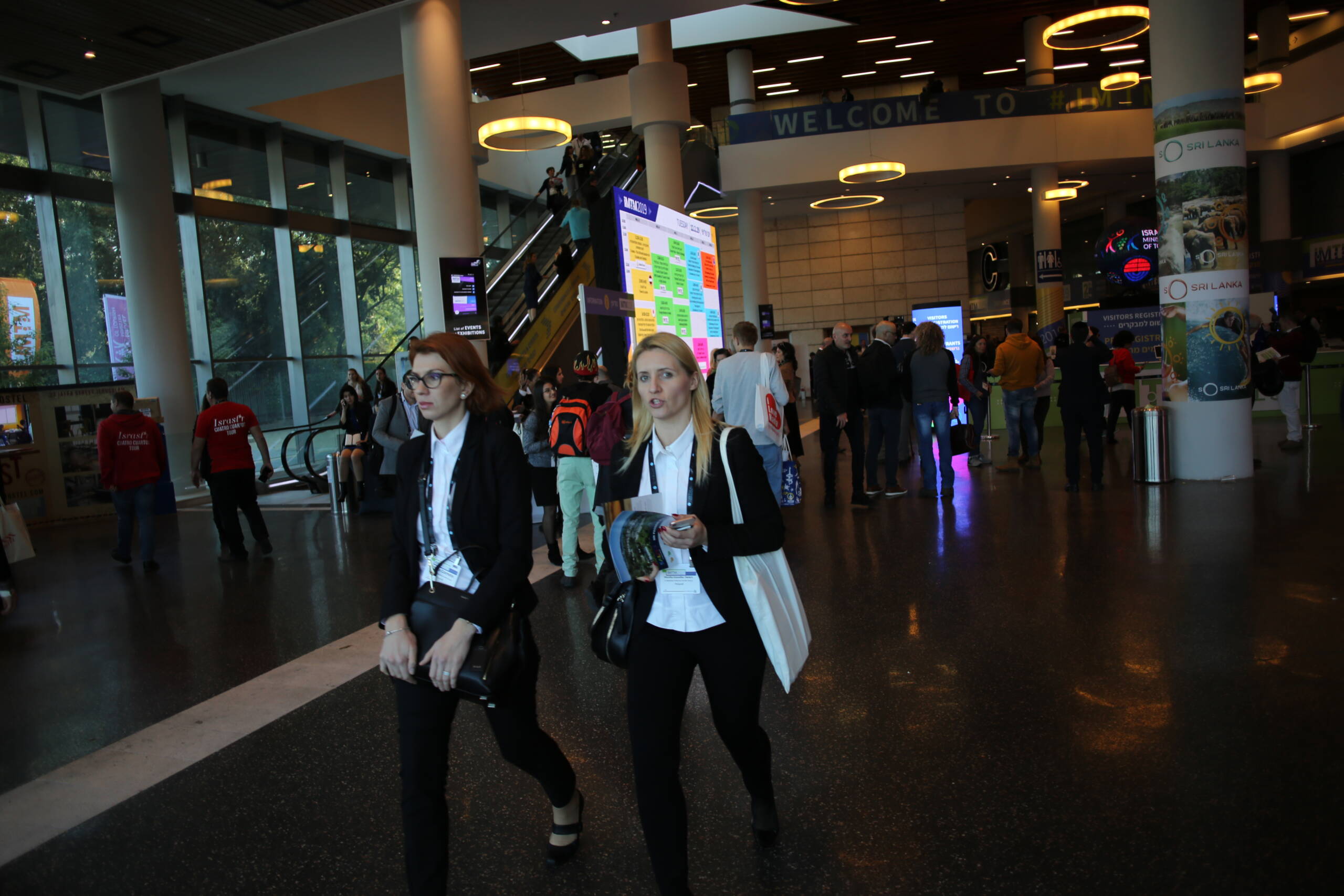The first time you walk into a major travel trade show, it can feel like stepping into a miniature world disguised inside a convention center. The photo here captures that sensation well: a wide entrance hall washed in soft interior light, escalators rising toward upper floors, clusters of people moving with brisk purpose. Two women in the foreground walk with intention, lanyards and badge holders swinging slightly as they move. One holds a folded map of the show’s layout, the other clutches her phone and bag, the kind of look that says we know where we need to be next, or we’re at least pretending we do. Behind them, the space is alive with the usual trade show choreography: people registering, chatting, checking timetables, reading signs, sizing up which booth to approach first. Suspended ring lights glow overhead like halos of conference energy. It’s the familiar atmosphere of professionals, buyers, sellers, storytellers, and dreamers all orbiting around travel, tourism, and the business of moving people across the world.

Preparing to attend one of these events is less about simply showing up and more about understanding the culture of exchange they create. Travel trade shows are marketplaces of ideas, deals, and future itineraries. Airlines meet tour operators, tourism boards meet travel media, hotels meet travel agencies, and freelance creators meet everyone. To get the most out of it, you need clarity before you ever walk inside. Ask yourself: are you here to buy, sell, network, learn, report, or scout? A journalist attending to research stories moves differently than a boutique travel agent looking for new partners. A tourism board marketing a region walks a different path than a content creator trying to secure hosted trips. Set your purpose early, write it down if needed, then shape your movements with it. Without that, you end up wandering a maze where everything seems interesting but nothing sticks.
Once the show begins, your most powerful tools are your feet, your schedule, and your ability to talk to strangers without sounding transactional. Study the map in advance. Note the zones: usually national tourism boards in one section, tour operators in another, aviation and booking platforms elsewhere, startup innovations tucked near the back. Plan meetings ahead of time if you can; many travel professionals book days full of 15–30 minute discussions. But also leave room to roam, because some of the most valuable interactions happen when you allow curiosity to guide you. If you see a booth for a region you’ve never considered, stop by. Let yourself be surprised. A travel trade show rewards openness because the travel world itself is built on the idea that discovery changes us.
Dress comfortably but professionally. You will walk more than you think. Carry a bag that can hold brochures, business cards, and the occasional piece of branded chocolate or dried mango that someone insists you try. A water bottle is essential. So are breaks. The hall in the photo feels bustling, but on your fifth hour the energy blurs, your brain fogs, and everyone starts sounding like they’re promising “authentic local experiences.” Step outside when needed, breathe actual air, reset your attention. Travel is sensory; so is talking about it. Your mind will work better when it has space to absorb new ideas.
Above all, remember that a travel trade show is not simply about exchanging business cards; it’s about forming memory-based trust. If you connect with someone in a way that feels human rather than purely strategic, that connection lasts. A shared laugh about airport chaos, a story about the first time you got lost in a city, a moment of honesty about what makes travel meaningful — these are the foundations of deals far more than polished pitches. The two women in the image, walking with a sense of direction, are embodiments of that dynamic. They are the kind of attendees who have a purpose but are still present in the moment, scanning the room, participating in its rhythm. They are moving toward conversations that might shape future partnerships, bookings, narratives, or journeys.
The true reason to attend a travel trade show is that it compresses the global travel ecosystem into a single physical environment for a brief moment in time. You can, in the span of a single day, speak with tourism representatives from Sri Lanka, a boutique hotel in Lisbon, a river cruise operator on the Danube, and a travel insurance startup looking to rethink risk. Your understanding of travel becomes layered, interconnected, and alive. You walk away not just with business prospects, but with the emotional memory of what travel actually feels like when it is still only an idea waiting to take form. And that, more than any brochure, is what inspires the journeys that follow.
Leave a Reply